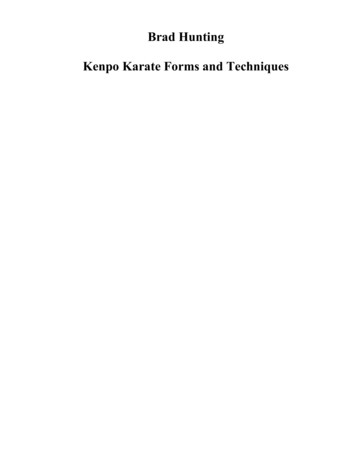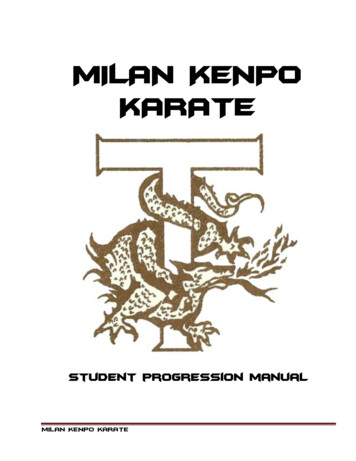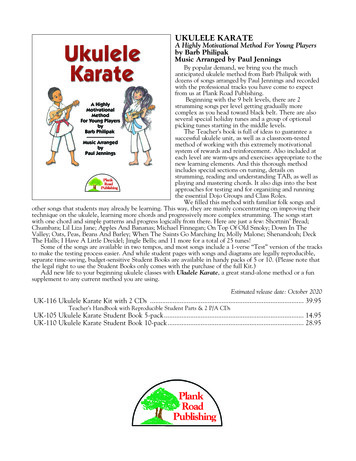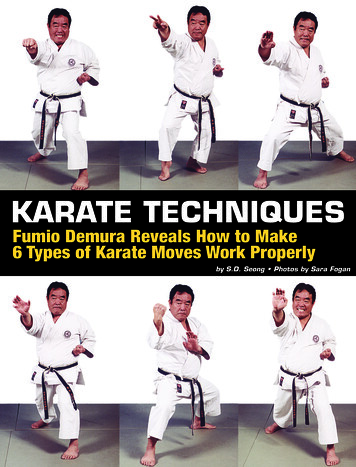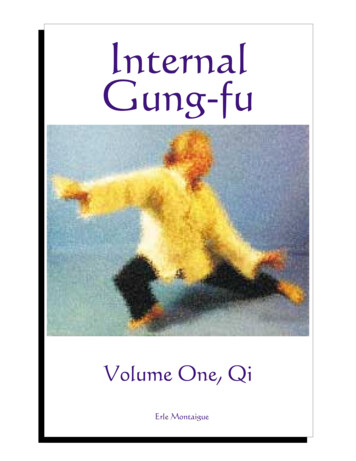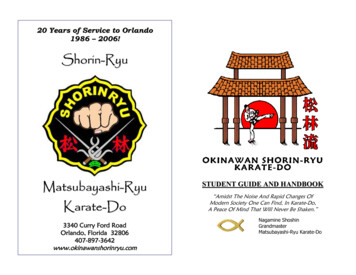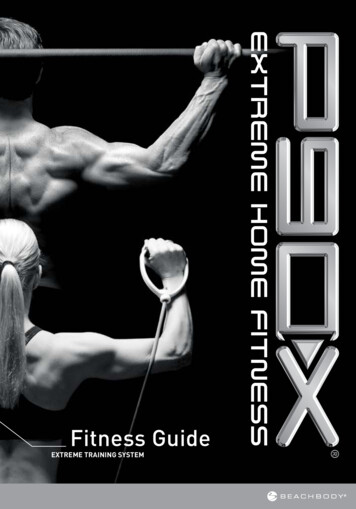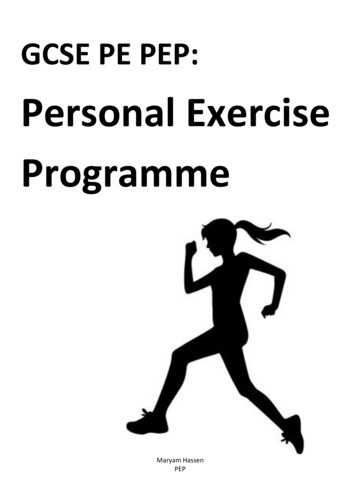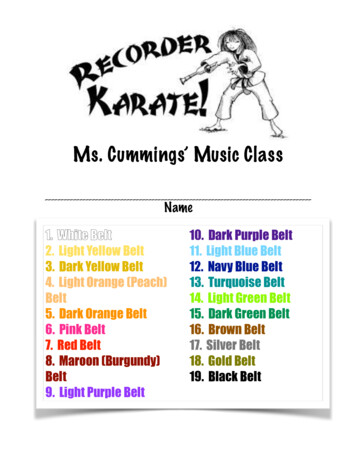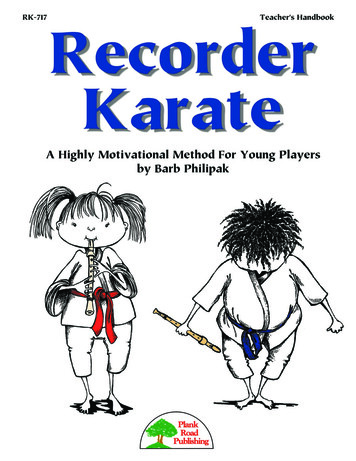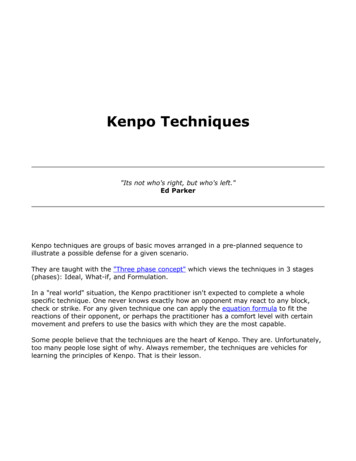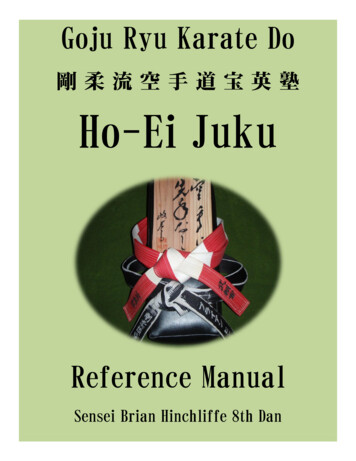
Transcription
Goju Ryu Karate Do剛柔流空手道宝英塾Ho-Ei JukuReference ManualSensei Brian Hinchliffe 8th Dan
Front Cover Photo;The Karate belts belong to Sensei Brian Hinchliffe 8th Dan founder of Ho-Ei Juku. The Wooden plaque ‘kanji’ written bySensei Hokama Tetsuhiro 10th Dan – Okinawa The words read; ‘Karate ni Sente Nashi’ – ‘There is no first strike in Karate’.
AcknowledgementsSensei Miyagi Chojun (1888-1953)This manual would not have been possible without significant contributions by so many people in my karate life, bothteachers and students. Therefore, I would like firstly to thank my teacher, Meiyo Kancho Tada Heiji (8th Dan), founder ofthe Seishikan, based in Kyoto, for his endless support and guidance in karate since the 1980s. Sadly, he passed away inSeptember 2013. I have been fortunate to have trained with and learnt from so many othersenior instructors in Goju Ryuand other karate schools, in Japan, the UK, the USA and around the world – and to all of them, I am forever indebted.As I began karate training in 1972, I have been able to train over the years with literally thousands of people as peers,students and teachers. When I began teaching karate in 1985, it was exciting to work with my own students and watchthem evolve. Some of those early students are still training with me now and each one of them has helped in keeping megoing through good times and bad, so I owe a massive thank you not just to my teachers, but also to those who havedecided, whether for a short time, or longer, to train with the Ho-Ei Juku group.Finally, I must thank the late, Sensei Morinaka Masakatsu (1929-2013), without whom there would be no Ho-Ei Jukuname. This will be discussed later. And of course, thank you, the reader, for taking the time to read this short manual andI trust it helps to explain in some small way the manner in which we train, measure our progress and attempt (as far as ispossible) to follow the excellent teachings and methods of our teachers from Japan and in particular the man consideredto be the founder of Goju Ryu, Sensei Miyagi Chojun, without whom, I sometimes wonder what I would be doing now.
ContentsIntroductionAn outline of the origins of our school; Goju RyuFundamentals of Goju Ryu Karate-DoTraining in Goju Ryu KarateGoju Ryu Karate Do Hoei Juku specific Dojo RulesWarm-up ExercisesThe Kyu/Dan Grade (coloured belt) systemThe Dojo KunStances of Goju RyuFootwork and movementKataBreathingKumite – practice fightingNatural Weapons of the bodyTraining combinationsThe 10 one-step moves explainedThe Syllabus for promotionGaining the Winning EdgeMartial Arts injuriesGoju Ryu TerminologyNotes
IntroductionIt has been my intention to write this student handbook for a very long time. With years of note-making and seminarnote preparation, plus assorted leaflets for the clubs, there is an abundance of material in circulation just waiting to becollated into one volume without too many pictures and with the essential information needed to gain a clearerunderstanding of Karate and in particular of Goju-Ryu Karate. With the incorporation of our own web-based links forvisual performance of movements in our style of Karate, I believe this is the perfect combination of easily accessibleinformation and action images that can be used to follow the movements. Despite this, I am well aware that this smallvolume can not answer all the questions or truly reflect the Art in its entirety. Therefore, this training manual is notintended to replace constant, regular training in a karate dojo under the guidance of an experienced Black Belt instructor.So, by taking on board all the information in this handbook and asking any further questions of your own Sensei, you willbe able to gain more than just the great benefits of health and fitness. There are many advantages to learning a MartialArt and to do this completely, it is also necessary to take on board the history and origins of the Art, the language used inpracticing that Art and the details required to acheive a senior level within the Association.Considering this, I hope that you practice hard on the techniques of Goju-Ryu, as there are so many physical aspects tothis form of Karate with its techniques, forms, body-conditioning and pair work. Study hard too, in order to learn theroots of the Art and be able to transmit this information to future generations of Martial Artists. In this way, we will all beable to maintain, as much as is possible, something close to the spirit of the Art as it was practiced by the great names inJapanese, Okinawan and Chinese Martial Arts over the centuries. Now that Karate is a household word around the world,it can so easily become no more than a shadow of its original form. Influences such as modern competition, financialincentives, egotistical individuals or merely the lack of information can change what was taken from Okinawa to mainlandJapan in the 1920s and 1930s to the point where it is almost unrecognisable as the same Art.I have found over the years that a great many students train in Karate without really worrying about which style it is, whothe Masters were in the history of the Art and so on. To some extent, the sylte itself is less important than the way inwhich you are training, the effort made by both teachers and students. It is my intention therefore to attempt to recordmany of the points that can often be ignored or forgotten in our hurry to get fitter, to lose weight, even to gain thecoveted black belt. Whilst it is important to set your own goals and timelines in training, it is also essential, in my mind, toremember that Karate-Do, the Way of the Empty Hand, is a true ‘Way’, and must retain the aspects of respect, humility,self-control and discipline that separate any Art from the many forms of kick-boxing, cage-fighting and other systems oftraining and competing in physical violence. The hardest part of Karate training should be to overcome our own innerweaknesses in pursuit of true Karate performance.Finally, with the advent of modern internet technology, we are able to provide various downloadable materials, links tomovie clips and other resources including a photo gallery on our website. The content of this does change from time totime, so for more information, please refer to www.hoeijuku.comI wish you well in your study and practice of Goju-Ryu Karate.Brian Hinchliffe 8th Dan
An outline of the origins of our School; Goju RyuThe origins and lineage of Goju Ryu can be traced back with certainty to the founder ofWhooping Crane Kung Fu; Xie Zhong Xiang (1852-1930). He was also called Ryu Ryu Koand was born in Chang-le, Fujian. In his early years, he studied Ming He Quan boxing. In1883, he set up a martial arts centre and started to receive students and pass on his styleof Chinese boxing with its own special and unique characteristics. He was a firstgeneration master (Shi) of Whooping Crane Boxing. Many believe that Xie was theteacher of Higashionna Kanryo and other turn-of-the-century Okinawan martial arists.Whether this was truly his real name and picture or his actual birth and death date,Whooping Crane strikingly resembles Goju Ryu and definitely plays a generous role inmany other Okinawan as well as Goju Ryu practices. Defined particularly in kata such asSuparunpai, Kururunfa, Saifa, etc; those Kata brought back to Okinawa from China eachdemonstrate specific movements from White Crane.Higashionna Kanryo (1851-1917) was born in Naha, Okinawa, which is now a prefecture of Japan. As so much evidencewas lost during the destruction of Okinawa in World War 2, some aspects are difficult to confirm. However, HigashionnaKanryo, having been born to a poor family, was reputed to have earned his livingtransporting firewood from the Kerama Island. Despite being very small in size, he hadunparalleled speed and agility. Kanryo Higaonna is known as the founder and highestauthority of Naha-Te and was a student of Ryu Ryu Ko. He is considered one of the earliestand foremost masters of Okinawan Karate and regarded as one of the most influentialKarate instructors in Okinawan history.Higashionna-Sensei sailed from Okinawa in 1866, at the age of 15 or 16 to further hisstudies in Fuzchou, China, in the arts of Chinese boxing with Ryu Ryu Ko and remainedthere for 15 to 20 years. When he returned to Okinawa he introduced a new, effectiveschool of Karate there, distinguished from other styles by its integration of Go- no (hard)and Ju-no (soft) Kempo into one system. Higaonna was noted for his powerful SanchinKata. Sometimes he would permit four men to attempt to push him out of his stance, but they were always unable tomove him. It is said that after finishing his Sanchin Kata, the wooden floor would be hot from the mere grip of his toes.His most prominent and best student was Chojun Miyagi, the founder of Goju-Ryu.Chojun Miyagi was born April 25th 1888 in Higashi-Machi (Naha-shi) Okinawa. When Miyagi Sensei was 11 years old, hismother took him to a karate master named Aragaki Ryuko. At the dojo of Aragaki Sensei, he trained mainly on makiwara,chishi, and nigiri-game, which were used to strengthen and develop the muscles. Later he introduced the young Miyagi toHigashionna Sensei. After watching the young Miyagi carrying out all of the chores around the house, the traditional wayof being accepted, Higashionna Sensei decided to have him as a personal disciple, and started to teach him his art.Miyagi Sensei's training was not confined just to the dojo. He ran every day from his High School, where he had enrolledpreviously, and he was seen at the harbour as well. Miyagi did a lot of body conditioning before he went to Higashionna'sdojo, but still found the training extremely hard and demanding. Higashionna's training was exhaustive, and Miyagi wouldpass out many an evening. Although the training was very hard, Miyagi was enthusiastic about his karate, andHigashionna Sensei was already thinking of him as his successor. Both were already working on the practice of kata andon the improvement of Naha-te. They stayed together for 15 years. After training with Higashionna Sensei, Miyagi sailedto China in May of 1915 in search of his Higashionna's teacher. This was one of three trips he made to China during his
lifetime. During his quest he studied Chinese boxing in Fouchow, Fukien Province, from 1915 to 1917. He studied not onlythe building blocks of his teacher’s art Hung Gar-Shaolin Chuan Chi-Chi, but also I-Chuan, Pa Kua Chang and Tai ChiChuan. All of these were softer but highly skilled and effective styles. It was at this time he learned the Kata Rokkishu,which later became the building block for Kata Tensho. With this additional martial art training Okinawa-te, Naha-te andthe Chinese arts, Sensei Miyagi developed a refined form of empty hand, although even today its Whooping CraneChinese Kung Fu roots can still be seen in its forms or Kata.In early 1917, Higashionna Sensei died, and Miyagi returned to Okinawa. After he buried his beloved teacher, he began toteach his Karate at a number of places in and around Naha, and to lecture and demonstrate throughout Japan. ChojunMiyagi's students primarily studied four Kata: Sanchin, Sesan, Seiunchin and Tensho.Training by himself now, Miyagi decided to approach his karate in a more "natural" way.He worked out in the forests and on the beaches. Sometimes he even practiced in thesnow for long periods of time to bring his karate closer to nature. Miyagi spent most ofhis time practicing karate and studying everything that could be related to Martial Arts.Miyagi-Sensei subjected the art of Naha-te, as received from Kanryo Higashionna, toscientific examination. He studied the basic Go (Sanchin) and the six rules and createdthe Ju (Tensho) form, combining soft and hard movements. Later, he created the katasGekisai Dai-Ichi and Dai-Ni. He also organized the auxiliary movements to strengthen thebody through calisthenics. He organized these exercises in preparation for practicing theclassical Kata. It can be said, he formulated the theory for the practice of Karate as aneducational subject, an art of self-defense, and as a spiritual exercise.During this time he also becomes a permanent officer of the Dai Nippon Butokukai. By 1936, Chojun Miyagi was trulyrecognized by the Government of Japan with being awarded the medal for "Excellence in the Martial Arts" from theJapanese Ministry of Education. On May 5th, 1937 - Miyagi Chojun Sensei performed Kata at the Butoku Sai for the DaiNippon Butoku-kai.To describe his system, Miyagi compared it to a willow tree standing against the wind, remaining stable because of itsstrong roots, while the branches flow and give with the force. With this concept he envisioned a new approach to Karate,combining it with hard and soft techniques to be used in countering hard blows and kicks. The naming of Goju-Ryu cameabout more by accident than design. In 1929 one of Chojun Miyagi Sensei’s disciples, Jinan Shinzato, was in Kyoto, Japanfor a large martial arts convention to demonstrate Naha-te.After the performance he was asked to what school of karatehe belonged. As Naha-te had no formal name he could notanswer this question. Feeling his art would be looked downupon he answered "Hango-ryu", which means the Way ofHalf Hard. Unable to accurately reply he returned to Okinawaand consulted Miyagi Sensei. He chose the name"Goju Ryu"(the hard-soft style), inspired by the "Eight precepts" ofKempo, written in the Bubishi; quoting from the third verse ofa Chinese Bubishi poem, the Eight Poems of the Fist: "The way of inhaling and exhaling is hardness and softness." It isfrom this poem that the art Miyagi studied and taught got its name; Goju-Ryu, the school of hard and soft.Following what is now known as the Meeting of the Masters, Mr. Miyagi along with others who attended formed the'Great Japan Martial Arts Karate Teachers Association' or 'Dai Nippon Butokukai Karate Jutsu-Kyoshi' in 1937. Before theSecond World War, Chojun Miyagi travelled widely and was involved in many projects to spread karate throughoutmainland Japan and the rest of the world. However, from 1948 until 1953 he remained in Okinawa. Before the war he
had been dedicated to his own training and research, to further develop the art of Goju Ryu Karate, but his purpose in lifehad now changed. He was intent on passing on Goju Ryu, and the "gokui" (secret principles) of Goju Ryu to the nextgeneration. Master Miyagi taught at his home, outside in his ‘Garden Dojo’. But he didn't teach regularly outside his ownpersonal students. During his 'sessions' Miyagi Sensei would teach the kata in great detail and explain the "bunkai" (kataapplications) thoroughly. Miyagi was content promoting and teaching his art. He felt no need to wear a uniform, a patch,create ranks, and so on. Miyagi never awarded a Black Belt to any of his students and believed himself unworthy ofgranting a black belt and that a black belt should be awarded by a member of the emperor's family or a sanctioning bodysuch as the Butokukai. He was in the process of writing a syllabus for Black Belt but he died before this was completed.Chojun Miyagi passed away on October 8th, 1953. He had not named a successor at the time of his death; leaving anunprecedented mark in the world of Karate-do and from his famous Garden Dojo, there were enough legendary studentsto carry his name into the history books of Martial Arts as the 'Master". He predicted that during the twentieth centurykarate would spread throughout the world. Today we can see that this prediction has been realized, karate is not onlypracticed in Japan, but it can be found throughout the world. Karate is no longer a solely Okinawan or Japanese martialart; it has become an art with no boundaries, an art for people all over the world.Meitoku Yagi, born on 6th March, 1912, was considered by many to be the highestranking and most thoroughly knowledgeable party on Goju Ryu after Miyagi’s death.He is a descendant of the original "36 families" who arrived in Okinawa from China in1392. Sensei Yagi began his training with Miyagi Sensei in 1926. For the first year of histraining, he was taught only Sanchin Kata. Every student was required to be proficientin Sanchin before they were allowed to begin training in other kata. The trainingsessions were long and brutal in the early 20th Century. When Yagi Sensei visited thelocal bathhouse, the local men would often comment about the bruises on his body,saying they could tell that he was training with Miyagi Sensei. In his youth, MeitokuYagi was known as "the makiwara breaker." He could break a typical punching board atwill, and occasionally sought out a particularly tough makiwara to break when otherssaid that it could not be done.Yagi was given Chojun Miyagi's belt and uniform from the Miyagi family - however, this Gi was purchased for MiyagiSensei by Ei'Ichi Miyazato when Miyazato went to Japan to compete in Judo. For many years it hung in the Meibu-KanDojo. After Master Miyagi passed away his family members had a meeting to decide who should be his successor. Theymade their decision based on loyalty, character, heritage and knowledge, and formally presented the Master's belt anduniform. Sensei Yagi remained a faithful student of his master, training and learningfrom him right to the point of Miyagi Sensei’s passing in 1953. On April 29, 1986, thelate Emperor Hirohito awarded Dai Sensei Yagi the 4th Order of Merit with this title,"Living National Treasure" for his outstanding contribution to Karate. (The EmperorHirohito decorated Yamaguchi Gogen earlier in 1968 with the Fifth Order of Merit aswell as Ranju-Hosho, the Blue Ribbon Medal). These awards recognize the recipientas a National Living Treasure and are entrusted only to the most distinguishedpersons for their contributions to Japanese Society.Gōgen Yamaguchi, born in 1909, was a world renown Grandmaster of JapaneseKarate-dō and founder of the Internantional Karate-do Goju-Kai; he was one of themost well known of all Karate-dō masters to come out of Japan. Prior to his death in1989, he was decorated by the Emperor of Japan in 1968 with the Blue RibbonMedal and the fifth order of merit, for his enormous contribution to the world wide spread of the Japanese martial arts.For many years Gōgen Yamaguchi was listed in the Guinness Book of Records regarding his rank and achievements. His
name was said to be a household word in Karate circles, and he appeared in all the major Martial Arts magazines andpublications, both in Japan and the western world. Gōgen Yamaguchi was also famously known in the world of karate-dōas ‘the Cat’; he was a very small man, just over five feet, however he projected the impression of great bulk and an aurareminiscent of the samurai era. He was first dubbed 'the Cat' by American GI’s for his gliding walk and flowing hair. Healone was primarily responsible for the spread of Goju-Ryu throughout the world today. According to Gōgen Yamaguchihimself when interviewed by French magazine Karate journalist Rolland Gaillac, April 1977 edition, "Even today, youngman, if you were to face me in combat, I would be able to determine in a second the strength of your Ki. Immediately Iwould know if you were a good opponent. It is this quality, and no other, which has given me the name of The Cat."Chōjun Miyagi Sensei visited the university dojo of Kansai, Osaka, Ritsumeikan and Doshisha Universities, whilst attendingRitsumeikan University in Kyoto. There, Gōgen Yamaguchi founded the Ritsumeikan daigaku karate kenkyū-kai, the firstkarate club in western Japan and infamous for its hard style training and fierce karate fighters. After graduating fromRitsumeikan University in Kyoto in 1934, Yamaguchi designed and introduced Jiyū-kumite which has become knowntoday as sport karate kumite. In 1935 he formed the All Japan Karate-do Goju-Kai Karate-dō Association, which later splitinto the JKF Gojukai and the J.K.G.A.Before the twenty-fifth anniversary of the death of Chojun Miyagi, Gogen Yamaguchi Hanshi went to his Dojo in Okinawato receive instruction in Kata in March of 1978. Gogen Yamaguchi Hanshi, former head of the All Japan Karatedo Goju RyuAssociation [JKGA], recognized Yagi Sensei as rightful heir to Chojun Miyagi Sensei’sSchool. Yamaguchi Hanshi studied with Chojun Miyagi Sensei for a short period of timeand represented Goju Ryu Karatedo on mainland Japan. Gogen Yamaguchi Hanshi visitedOkinawa many times (also Yagi visited Tokyo) to compare Kata and receive instruction inthe advanced methods of Goju Ryu. Yagi Sensei has said “When I used to go used to TokyoI would train at Gogen Yamaguchi’s Dojo and teach Goju Ryu to his youngest sons anddaughter. I should say that if you study in the modern day JKGA of their Dojo you can haveconfidence that you are learning the advanced methods of Goju Ryu.” The standard andquality of Miyagi’s Goju-Ryu Karate has been kept alive over the decades by the relentlessefforts and devotion to training of a great many Masters in different organisations.Kancho Tada Heiji was one of the earliest students of the Ritsumei-Kan dojo andestablished the first of his ‘Seishikan’ dojo in Tambabashi, Kyoto in 1949. The three ‘Tadabrothers’ became well-known in Karate circles as in addition to successful dojo in Kyoto and the surrounding areas ofOsaka and Nara, Tada Masao Sensei spread the Seishikan brand of karate in Australia, where he lived for several years.Kancho Tada Heiji studied Karate with Yamaguchi Gogen and also under the expert guidance of Yagi Meitoku in Okinawa.The Seishikan became quite a formidable competitive school from the 1970s, with successes in tournaments in Japan andAustralia against all other styles. Meiyo-Kancho Tada Heiji passed away in September 2013.Brian Hinchliffe first met Kancho Tada in Kyoto in 1989, whilst on a tour ofJapan and taking part in the 15th annual Goju-kai championships as amember of the England Goju-Ryu Karate-Do Seiwa-Kai karate team of thatyear. After extensive correspondence, a return visit to Japan in 1991 was thetrue beginning of this very fortunate and special relationship. The Seishikanwas subsequently formed in the UK and successful groups operated in thesouth east of England, headed by Brian Hinchliffe, where twice-annual,karate competitions were held for many years and seminars were offeredunder senior Japanese instructors, including Kancho Tada himself, whovisited England in 1991.
As Brian Hinchliffe spent time in Japan occasionally, he was fortunate to be accommodated in Kancho Tada’s home for awhile then went to live at the Obaku Mampuku-Ji temple near Uji, where there were dojo practicing Judo and Kendo aswell as Karate. This daily life and training at the Mampuku-Ji changed Brian's whole out look on life and the Martial Arts.Studying the Chinese forms of Chi Gung, and health exercises such as the Eight Pieces of Brocade. This was also the firstreal exposure to the Japanese sword arts and eventually led to Brian Hinchliffe meeting, and being accepted as an iaidostudent of, Sensei Morinaka Masakatsu.Over time, it became clear that operating several dojo in the UK practicing different arts under several different nameswas difficult to manage. Morinaka Sensei suggested the name Ho-Ei Juku (meaning literally ‘the school of unitedtreasures’) and this was gratefully accepted. Morinaka Sensei’s dojo in Japan was the Ho-Sei Juku and his teacher, thelegendary Iwata Sensei’s dojo was called Ho-Nan Juku, so the name was a natural cnoice, using the word Ei from theJapanese name for the United Kingdom, Ei-Koku.Now we can say welcome to the Goju-Ryu Karate-Do Ho-Ei Juku. We are a non-political, independent karate clubpracticing Goju-Ryu style karate and our senior members can go on to learn Muso Jikiden Eishin Ryu Iai-jutsu. Thefounder and chief instructor of the Ho-Ei Juku, BrianHinchliffe, established his group with the formation of theBlue Tiger Karate Club in Hastings in 1985. There has beenextensive change and development since those early days.We are, however, delighted to keep this unusual name that isdifficult to pronounce as it reflects the lineage and tradition ofa true Art form, handed down from the teachers of old.Morinaka Sensei sadly passed away in April 2013.Brian Hinchliffe has been privileged to receive his gradesdirectly from the Dai Nippon Butoku Kai in Japan and in 2008was graded to 7th Dan in Goju-Ryu Karate and 5th Dan inIaido. Starting training in Martial Arts in 1972 and studying various Arts along the way, Brian has trained with many of theworld’s leading Masters in both Goju-Ryu Karate and Iaido. The path has led Brian across the world to train, compete andteach seminars across Europe, the USA and of course, the Far East. In 2014, Brian became a member of the Zen NihonBudo Renmei, based in Kyoto, Japan. In 2015, Brian was presented with an International Teaching Licence and graded to8th Dan by the Zen Nihon Sogo-Budo Renmei, Nihon Seibukan Dojo of Kyoto. This promotion will ensure the futureconnection to Japan for the Hoei Juku and its members and open the door to many opportunities to travel, meet andtrain with today’s Masters of Goju-Ryu Karate in Japan and around the world.
Fundamentals of (Goju-Ryu) Karate-Do.The Goju-Ryu style of Karate is composed of both ‘hard’ and ‘soft’ aspects as influenced by the Chinese heritage;sometimes called the opposites of yin and yang (In-Yo, in Japanese). This is what brings such a unique quality to our waysof training. The eternal life of the universe develops together with positive and negative energies, bringing nature intobalance.Masters in days gone by endured strict and rough practice in order to survive and protect themselves with Karate as theirmeans of fighting. There is evidence of this primitive side of Karate in Kata such as Sanchin, which typifies the ‘Go’ ofGoju-Ryu. In Sanchin, the whole body is kept under extreme tension, never off guard for a second. On the other hand,Tensho does not show a strong fighting spirit, drawing gentle, flowing curves through the air with some of the power ofSanchin. Techniques change in an instant from hard to soft, or soft to hard. The breathing method we use, called ‘ibuki’,is a conscious method of breathing, helping to concentrate the muscles, and calm the mind. In this method, we matchmovements of ourselves and the opponent, with the breathing. Goju-Ryu has many postures that come from the oldChinese animal forms. To imagine a lion roaring is to perform correct breathing. When animals fight, it is life, or death.One reason that the old Bu-jutsu is evident in modern Budo arts is that we see the importance of posture, breathingtechniques and animal form methods. However, if there is hard ‘Go’ on one side, there must also be a softer ‘Ju’ on theother as a balance. Karate-Do should give you an edge over others and yourself and it becomes a precept of thetraditional Japanese ‘Do’. This practice is invaluable as self-discipline and health are also long-term training aims.In modern times, we can study Karate as a sport, but that depends on how you interpret Karate. Is Karate still relevant asa martial ‘way’ of exercising, a ‘Budo’ form, or is it solely a sport? When you compare the rules, you might think it’s nodifferent to other sports; the main purpose of many sports partly being to train the mind and body. This applies to Budotoo. There are now sport forms for Judo, Kendo and Karate. They have been modified to conform to rules that enableathletes to compete and win titles. There will however be a signifinant difference in the mental attitude between peoplewho practice Karate as a sport, and those who practice as a Budo form – and the latter can be a life-long persuit.In learning techniques and developing good Karate, it is useful to keep the mind of competition in your training up toabout 2nd, or 3rd Dan level, whether competing against others, or aiming to improve your own level or performance.That would probably be during the first six to ten years, in which time a good solid foundation can be made. After this,3rd Dans and above would probably consider clarifying their training in their own minds. Some have the need to consider‘reality’ in their training, discarding much of the classical tradition and working on techniques they need to apply in theirlife, or working environment. Members of the armed forces, bodyguards and so on will have a need for this. The style oftraining undertaken will allow students to clarify meanings in the Kata they have learnt, and apply additional techniquessuch as joint-locks and pressure points. This style of training can be uncompromising and extremely dangerous. It mustbe born in mind that technique alone is not enough. Determination will overrule even the best of technicians if theirheart is not in it.To truly find enlightenment through the rigors of Martial Art training does take a very long time. All the aspects of goodtechnique, posture, breath control, endurance, discipline, mental attitude, duration (and others), are all necessary on the‘way’. How you approach the ‘way’ is a personal thing. A Sensei can only guide his students in the way he knows. The restis up to the individual.
Training in Goju-Ryu KarateReasons for trainingIt’s fun – yes, it might feel like it hurts sometimes, but training is very enjoyable. Goju-Ryu is a mix of hard and softmovements and there is something there for everyone. Karate provides the young with an excellent example in disciplineand manners. Training in a disciplined activity builds strength in the young to face challenges in the future. There isalways the aim of achieving the next goal in training and more to be learnt. Compared to so many activities these days,Karate training need not be at all expensive. There are significant health and fitness benefits from regular exercise.Training in Karate teaches the ability to behave equally graciously in success and in fa
Whooping Crane Kung Fu; Xie Zhong Xiang (1852-1930). He was also called Ryu Ryu Ko and was born in Chang-le, Fujian. In his early years, he studied Ming He Quan boxing. In 1883, he set up a martial arts centre and started to receive students and pass on his style of Chines
